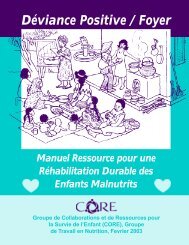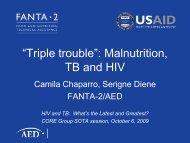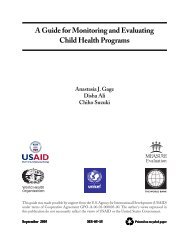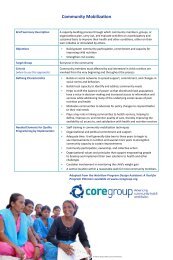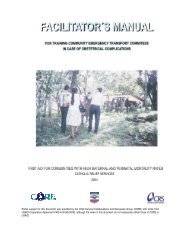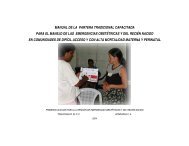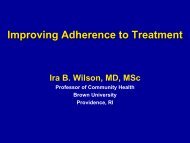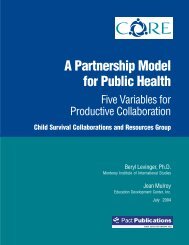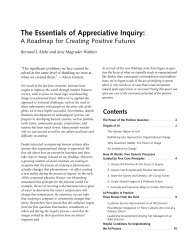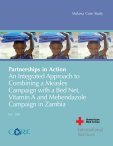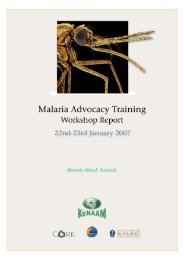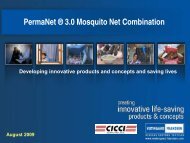NGO Malaria Secretariats: Foundations for Advocacy ... - CORE Group
NGO Malaria Secretariats: Foundations for Advocacy ... - CORE Group
NGO Malaria Secretariats: Foundations for Advocacy ... - CORE Group
- No tags were found...
You also want an ePaper? Increase the reach of your titles
YUMPU automatically turns print PDFs into web optimized ePapers that Google loves.
<strong>NGO</strong> <strong>Malaria</strong> <strong>Secretariats</strong>:<br />
<strong>Foundations</strong> <strong>for</strong> <strong>Advocacy</strong> and Impact<br />
A Kenya Case Study<br />
March 2009<br />
© 2007 Bonnie Gillespie, Courtesy of Photoshare<br />
www.coregroup.org
<strong>CORE</strong> <strong>Group</strong> fosters collaborative action and learning to advance the effectiveness<br />
and scale of community-focused public health practices. Established in 1997,<br />
<strong>CORE</strong> <strong>Group</strong> is a 501(c)3 membership association based in Washington, DC that<br />
is comprised of citizen-supported <strong>NGO</strong>s working internationally in resource poor<br />
settings to improve the health of mothers, children, and communities.<br />
<strong>CORE</strong> <strong>Group</strong> generates new partnerships in which non-governmental organizations<br />
(<strong>NGO</strong>s) can be engaged in in<strong>for</strong>mation sharing, capacity building, national level<br />
advocacy, and innovative, evidence-based programming <strong>for</strong> malaria prevention and<br />
control. <strong>CORE</strong> <strong>Group</strong> has been instrumental in the creation of national <strong>NGO</strong> malaria<br />
secretariats in four countries: Kenya, Tanzania, Uganda, and Zambia. In Kenya, the<br />
Kenya <strong>NGO</strong>s Alliance Against <strong>Malaria</strong> (KeNAAM) was established in September<br />
2003 with the goal to create a <strong>for</strong>um to bring together non-governmental, faith-based,<br />
and community-based organization members to address malaria control and prevention<br />
approaches, challenges, and policies. For more in<strong>for</strong>mation, see http://www.<br />
kenaam.or.ke.<br />
This report was written and edited by Karen LeBan and Shannon Downey (<strong>CORE</strong><br />
<strong>Group</strong>), and consultant Julia Ross, with input from consultant Mary Anne Fitzgerald.<br />
<strong>CORE</strong> <strong>Group</strong><br />
Website: www.coregroup.org<br />
E-mail: contact@coregroup.org
Table of Contents<br />
Backround..............................................................................................1<br />
Secretariat Model...................................................................................3<br />
KeNAAM’s Evolution and Growth..........................................................4<br />
Vision, Mission, and Values..............................................................5<br />
KeNAAM Objectives.........................................................................5<br />
Key Activities....................................................................................6<br />
Accomplishments...................................................................................8<br />
Civil Society Coordination.................................................................8<br />
<strong>Malaria</strong> <strong>Advocacy</strong>.............................................................................8<br />
Linkage with the Global Fund...........................................................9<br />
Lessons Learned.................................................................................10<br />
Conclusions.........................................................................................13<br />
<strong>NGO</strong> <strong>Malaria</strong> <strong>Secretariats</strong><br />
i
Background<br />
Established in 1997, <strong>CORE</strong> <strong>Group</strong> is a membership association of international<br />
non-governmental organizations (<strong>NGO</strong>s) whose mission is to generate collaborative<br />
action and learning to improve and expand community-focused public health<br />
practices <strong>for</strong> underserved populations around the world. Among its diverse activities<br />
that have led to improved health outcomes in the marginalized communities where<br />
member <strong>NGO</strong>s work, <strong>CORE</strong> <strong>Group</strong> has contributed to the <strong>for</strong>mation of several<br />
country-level networks that provide space <strong>for</strong> dialogue and joint programming among<br />
<strong>NGO</strong>s working in malaria prevention and control.<br />
In 1999 <strong>CORE</strong> <strong>Group</strong>’s <strong>Malaria</strong> Working <strong>Group</strong>, comprised of representatives from<br />
<strong>CORE</strong> <strong>Group</strong> member organizations and partners, mobilized <strong>NGO</strong>s to address<br />
malaria control and prevention needs. Members were concerned that malaria was<br />
an under-addressed killer of children under the age of five. <strong>Malaria</strong> ranks among the<br />
major health and development challenges in the world’s poorest nations. Children<br />
under the age of five and pregnant women are most at-risk and suffer the greatest<br />
rates of mortality from infection.<br />
In recognition of malaria’s impact on the health of mothers, children, and communities,<br />
<strong>CORE</strong> <strong>Group</strong>’s <strong>Malaria</strong> Working <strong>Group</strong> hosted a series of regional and country<br />
“Fresh Air” malaria workshops, which brought together a range of <strong>NGO</strong>, faithbased,<br />
Ministry of Health, academic, private sector, and multilateral representatives<br />
to discuss state-of-the-art practices, share programmatic experience, and plan how to<br />
work together to achieve the “Abuja Declaration” targets <strong>for</strong> malaria.<br />
As an outgrowth of these meetings, by 2003, four high-priority countries (Kenya,<br />
Tanzania, Uganda, and Zambia) established national <strong>NGO</strong> “secretariats” to support<br />
ongoing networks to facilitate in<strong>for</strong>mation sharing, problem solving, and leveraging<br />
of resources. The secretariats also sought to create a unified voice <strong>for</strong> <strong>NGO</strong> advocacy<br />
and participate in national, regional, and global level dialogues on malaria,<br />
health, and development. Support <strong>for</strong> the secretariats was coordinated through <strong>CORE</strong><br />
<strong>Group</strong>’s <strong>Malaria</strong> Working <strong>Group</strong>, which engages in existing national collaborative<br />
partnerships and promotes new partnerships in which <strong>NGO</strong>s can involve national<br />
policy <strong>for</strong>mation and innovative programming to scale up malaria prevention and<br />
control.<br />
Although there have been important gains against malaria in recent years, mechanisms<br />
<strong>for</strong> civil society engagement in malaria programming have remained limited.<br />
To effectively combat malaria, which infected 247 million people and caused nearly<br />
a million deaths in 2006, <strong>NGO</strong>s need mechanisms to share in<strong>for</strong>mation and program<br />
strategies among themselves and to better align their work with government strategies.<br />
A coordinated approach involving many partners is needed to fully reach global<br />
targets <strong>for</strong> malaria reduction.<br />
<strong>CORE</strong> <strong>Group</strong>’s experience and lessons learned in supporting and helping to grow<br />
country-level <strong>NGO</strong> networks serve as a model <strong>for</strong> other countries and programs interested<br />
in organizing similar ef<strong>for</strong>ts. This case study focuses on a network model in<br />
Kenya, where <strong>CORE</strong> <strong>Group</strong> works with the Kenya <strong>NGO</strong>s Alliance Against <strong>Malaria</strong><br />
<br />
<br />
<strong>CORE</strong> <strong>Group</strong> members developed the title “fresh air” <strong>for</strong> national malaria workshops as a counterpoint<br />
to “bad air.” The word “malaria” is derived from the Italian <strong>for</strong> “bad air.”<br />
By signing the Abuja Declaration in 2000, African leaders committed themselves to an intensive<br />
ef<strong>for</strong>t to halve the malaria mortality <strong>for</strong> Africa’s people by 2010 through implementing strategies<br />
and actions <strong>for</strong> Roll Back <strong>Malaria</strong>.<br />
<strong>NGO</strong> <strong>Malaria</strong> <strong>Secretariats</strong> 1
(KeNAAM) to implement a locally appropriate civil society partnership <strong>for</strong> engaging<br />
with the private sector, government, and other partners in the national fight against<br />
malaria. The purpose of this paper is to describe KeNAAM’s evolution and accomplishments,<br />
and present lessons learned in Kenya as a case study of a secretariat <strong>for</strong> a<br />
<strong>NGO</strong> network.<br />
<br />
<strong>NGO</strong> <strong>Malaria</strong> <strong>Secretariats</strong>
Secretariat Model<br />
The idea <strong>for</strong> malaria secretariats was first discussed at a Fresh Air <strong>Malaria</strong> Conference<br />
in East Africa in 2001, organized by <strong>CORE</strong> <strong>Group</strong> and the African Medical and<br />
Research Foundation (AMREF) with funding from the U.S. Agency <strong>for</strong> International<br />
Development (USAID). The conference was part of an ef<strong>for</strong>t by <strong>CORE</strong> <strong>Group</strong> to<br />
strengthen linkages, collaboration, and networking among <strong>NGO</strong>, government, private<br />
sector, and multilateral partners in malaria and child health <strong>for</strong> more effective ef<strong>for</strong>ts.<br />
One of the action steps resulting from this regional workshop was the organization<br />
of national malaria workshops in five countries to mobilize <strong>NGO</strong> and partner participation<br />
to reduce the incidence and impact of malaria. In four of these countries—<br />
Kenya, Tanzania, Uganda, and Zambia—<strong>NGO</strong>s came together following the national<br />
workshop to develop a mechanism to enhance collaboration amongst themselves and<br />
between the <strong>NGO</strong> and public sector.<br />
The KeNAAM Secretariat<br />
•<br />
Facilitates in<strong>for</strong>mation<br />
sharing, problem solving,<br />
and leveraging of<br />
resources<br />
• Seeks to create a unified<br />
voice <strong>for</strong> <strong>NGO</strong> advocacy<br />
and participate in national,<br />
regional, and global level<br />
dialogues on malaria,<br />
health, and development<br />
The secretariats requested funding and technical assistance from <strong>CORE</strong> <strong>Group</strong> to<br />
support collaboration and organizational development. Although each secretariat<br />
matured in different ways in response to local opportunities, each hired a coordinator<br />
and developed a workplan of key initiatives.<br />
While the first activity often involved one or more workshops to exchange in<strong>for</strong>mation<br />
related to malaria, activities eventually progressed to involve Roll Back <strong>Malaria</strong><br />
(RBM), the Global Fund, the ministries, and partners in Integrated Management of<br />
Childhood Illness (IMCI) programming and advocacy. In each country, the malaria<br />
secretariat was originally “hosted” by a <strong>CORE</strong> <strong>Group</strong> member organization and<br />
reported to a steering committee of <strong>NGO</strong> and partner representatives.<br />
<strong>CORE</strong> <strong>Group</strong> provided limited financial support and organized technical assistance<br />
and workshops to enable the secretariats to mentor each other, sharing lessons learned<br />
and organizational and management experience. Beginning in 2003, secretariat staff<br />
met periodically to jointly problem solve in areas including building organizational<br />
capacity, setting up monitoring and evaluation systems, establishing strong relationships<br />
with national Ministries of Health, documenting network achievements, and<br />
strategizing <strong>for</strong> fundraising. <strong>CORE</strong> <strong>Group</strong> also provided training in advocacy and<br />
facilitated strategic relations with global partners.<br />
<strong>NGO</strong> <strong>Malaria</strong> <strong>Secretariats</strong> 3
KeNAAM’s Evolution and Growth<br />
In 2002, Kenyan civil society organizations working in malaria decided they needed<br />
to speak with a unified, authoritative voice to the Ministry of Health. Specifically,<br />
they wanted to use advocacy to improve the delivery of malaria control and prevention<br />
programs to underserved communities. They decided they needed a central<br />
entity, or network, that could map out and coordinate civil society resources, skills,<br />
and programs, as well as translate government policies into actionable interventions<br />
<strong>for</strong> local community-based organizations, enabling civil society to participate more in<br />
the national fight against malaria.<br />
Kenya-based members of <strong>CORE</strong> <strong>Group</strong>’s <strong>Malaria</strong> Working <strong>Group</strong> established a<br />
steering committee to <strong>for</strong>m such a network, including a broad mix of international<br />
and local <strong>NGO</strong>s. The network’s original founders included:<br />
Sustainable Healthcare Enterprise<br />
Foundation<br />
AID Africa Concern<br />
African Medical and Research<br />
Foundation<br />
Academy <strong>for</strong> Educational Development/<br />
Netmark<br />
World Vision Kenya<br />
Plan International<br />
Christian Children’s Fund Kenya<br />
Vestergaard Frandsen<br />
MERLIN<br />
AfriAfya<br />
Population Services International<br />
Catholic Relief Services<br />
Kenya Red Cross Society<br />
International Medical Corps<br />
National AIPCA Health and Welfare<br />
Organization<br />
International Center <strong>for</strong> Insect<br />
Physiology and Ecology<br />
JHPIEGO<br />
To get KeNAAM off the ground, <strong>CORE</strong> <strong>Group</strong> provided a seed grant <strong>for</strong> first-year<br />
activities, with funding from USAID’s Africa Bureau. Members drew up a budget<br />
and workplan, and signed a hosting agreement with AMREF’s Kenya office because<br />
KeNAAM had not yet <strong>for</strong>mally registered as an <strong>NGO</strong> and had limited capacity. By<br />
November 2003, KeNAAM’s steering committee had hired a chief executive officer<br />
to build and engage the network’s membership, and represent civil society concerns<br />
related to malaria be<strong>for</strong>e government, multilateral, and private sector bodies.<br />
The hosting arrangement with AMREF, under which KeNAAM was able to share<br />
both AMREF’s office space and financial and human resources staff, was key to<br />
KeNAAM’s early growth. The secretariat benefited from AMREF’s good standing in<br />
government circles and a reputation <strong>for</strong> sound operational systems, but the relationship<br />
also benefited AMREF by strengthening the organization’s relationship with<br />
Kenyan civil society and solidifying its reputation as a valued partner in malaria<br />
programming in Kenya. KeNAAM benefited from global malaria in<strong>for</strong>mation,<br />
contacts, and guidance from the <strong>CORE</strong> <strong>Group</strong>, which it could disseminate to its<br />
members and use <strong>for</strong> national advocacy purposes. <strong>CORE</strong> <strong>Group</strong> benefited from and<br />
was able to use data and in<strong>for</strong>mation from KeNAAM members to spotlight need <strong>for</strong><br />
new innovations, guidance, and global advocacy.<br />
<br />
<strong>NGO</strong> <strong>Malaria</strong> <strong>Secretariats</strong>
Vision, Mission, and Values<br />
KeNAAM became a legally registered entity in 2006. To guide the organization’s<br />
development and reflect its <strong>for</strong>mal status as a legal <strong>NGO</strong>, the steering committee set<br />
<strong>for</strong>th the following vision, mission, and values statement.<br />
Vision: Within the broader context of public health in Kenya, KeNAAM aims to<br />
facilitate collaboration amongst stakeholders <strong>for</strong> effective delivery of malaria control<br />
and related interventions.<br />
Mission: KeNAAM is committed to supporting the equitable realization and sustainability<br />
of resources in Kenya through synergistic scaling up of effective malaria and<br />
control tools towards the achievement of Millennium Development Goals.<br />
Values:<br />
•<br />
Establishing a close working relationship with the Ministry of Health and Education;<br />
• Promoting and fostering evidence-based malaria interventions;<br />
•<br />
•<br />
Securing higher compliance among members <strong>for</strong> the National <strong>Malaria</strong> and Health<br />
Sector Strategic Plan;<br />
Supporting and strengthening use of monitoring and evaluation systems among<br />
all members within the framework of the National <strong>Malaria</strong> and Health Sector<br />
Plan;<br />
• Promoting high-quality per<strong>for</strong>mance among members;<br />
• Developing advocacy policies and creating malaria intervention awareness; and<br />
•<br />
Enhancing transparency through open communication and feedback to the public<br />
and all other stakeholders.<br />
KeNAAM Objectives<br />
In 2006, the steering committee also crafted organizational objectives, including:<br />
1.<br />
2.<br />
3.<br />
4.<br />
5.<br />
To conduct and carry out malaria advocacy among all stakeholders and the public<br />
in Kenya;<br />
To provide an opportunity to integrate malaria interventions into health and other<br />
related development interventions through proactive social and administrative<br />
mobilization of the civil society;<br />
To mobilize additional resources <strong>for</strong> scaling up malaria prevention and control<br />
activities;<br />
To enhance greater engagement of non-governmental organization and private<br />
sector actors as players in the Roll Back <strong>Malaria</strong> initiatives at community,<br />
district, provincial and national levels by increasing the voice of civil society in<br />
relevant <strong>for</strong>ums;<br />
To provide leadership and coordination of the non-governmental, community-based,<br />
and faith-based organizations, and the private sector, in scaling up<br />
evidence-based malaria control and prevention activities;<br />
<strong>NGO</strong> <strong>Malaria</strong> <strong>Secretariats</strong> 5
6.<br />
7.<br />
8.<br />
To facilitate dialogue and better domestic understanding of national and global<br />
health policies and tools;<br />
To enhance coordination amongst different stakeholders in the fight against<br />
malaria; and<br />
To facilitate accelerated implementation and scaling up of best practices.<br />
Key Activities<br />
In its early years, 2003-2005, KeNAAM developed its organizational structure and<br />
launched a suite of basic activities that became more complex over time. These<br />
included building a membership base, organizing civil society representation in<br />
national and regional policy <strong>for</strong>ums, and coordinating with the Global Fund.<br />
With a start-up grant of $65,000 from <strong>CORE</strong> <strong>Group</strong> (<strong>for</strong> the first year), KeNAAM<br />
brought members together to brainstorm on how to engage government and private<br />
sector partners; supported the salary of a part-time coordinator; hosted a national<br />
Fresh Air conference with its partners; and conducted a mapping exercise to identify<br />
members’ resources and programs. Other start-up activities included holding monthly<br />
steering committee meetings, quarterly member meetings, and an annual general<br />
meeting.<br />
<strong>CORE</strong> <strong>Group</strong> funding <strong>for</strong> KeNAAM continued in 2005 and 2006 via two $15,000<br />
contracts <strong>for</strong> workshops and civil society coordination.<br />
KeNAAM coordinated members’ Global Fund Round 4 submissions and built<br />
member capacity and recognition through participating in malaria <strong>for</strong>ums held by<br />
USAID, World Health Organization, U.K. Department <strong>for</strong> International Development,<br />
RBM, JHPIEGO. and other groups. KeNAAM members also began joint work<br />
planning with the East African Regional Network-Roll Back <strong>Malaria</strong> and the Global<br />
Fund during this period.<br />
In 2006, <strong>CORE</strong> <strong>Group</strong> secured a three-year, $414,000 subcontract with KeNAAM,<br />
from the Johns Hopkins Bloomberg School of Public Health Center <strong>for</strong> Communication<br />
Program, to implement the VOICES <strong>for</strong> a <strong>Malaria</strong>-Free Future project. Under<br />
VOICES, KeNAAM’s objectives included increasing community access to ACTs;<br />
increasing the Ministry of Health’s malaria budget; increasing community access<br />
to the Global Fund; and promoting better quality data on malaria morbidity and<br />
mortality.<br />
Through the VOICES project, KeNAAM built on its representational strengths to<br />
become a major advocate <strong>for</strong> malaria. Continued funding enabled KeNAAM to<br />
increase its staffing levels, develop communication tools such as a website and newsletter,<br />
develop an advocacy agenda to improve community access to treatment and<br />
preventive interventions, work with journalists, and become a national civil society<br />
representative <strong>for</strong> malaria.<br />
Specific activities included advocating <strong>for</strong> the removal of barriers that affect the<br />
delivery of essential malaria interventions, and building the capacity of malaria advocates<br />
to implement targeted communications and mobilization ef<strong>for</strong>ts. KeNAAM held<br />
advocacy workshops <strong>for</strong> members and the media, and recruited malaria “champions”<br />
in schools, through sporting events and Boy Scout troops. KeNAAM recruited local<br />
legislators, village chiefs, imams and religious leaders to disseminate key malaria<br />
advocacy messages, and introduced the subject of malaria into school curricula.<br />
<br />
<strong>NGO</strong> <strong>Malaria</strong> <strong>Secretariats</strong>
KeNAAM coordinated <strong>NGO</strong> applications <strong>for</strong> Global Fund Round 8 funding based<br />
on member requests, and consulted on development of guidelines <strong>for</strong> the distribution<br />
and importation of anti-malarials in Kenya.<br />
From 2006 to 2008, <strong>CORE</strong> <strong>Group</strong> continued to provide technical assistance and<br />
support to KeNAAM to link the secretariat with other international advocates and<br />
<strong>for</strong>ums, to enable two-way sharing of in<strong>for</strong>mation, and to promote KeNAAM’s<br />
accomplishments. <strong>CORE</strong> <strong>Group</strong> supported KeNAAM to attend global and regional<br />
Roll Back <strong>Malaria</strong> meetings and <strong>CORE</strong> <strong>Group</strong> membership meetings in the United<br />
States, and to present on the roles and need <strong>for</strong> secretariats at malaria conferences in<br />
other countries.<br />
KeNAAM Activities<br />
•<br />
•<br />
•<br />
Organizing civil society<br />
representation in national<br />
and regional policy <strong>for</strong>ums<br />
Increasing community<br />
access to ACTs, increasing<br />
the MOhs malaria budget,<br />
Increasing community<br />
access to the Global Fund<br />
•<br />
Promoting better quality<br />
data on malaria morbidity<br />
and mortality<br />
• Building the capacity<br />
of malaria advocates<br />
to implement targeted<br />
communications and<br />
mobilization ef<strong>for</strong>ts<br />
<strong>NGO</strong> <strong>Malaria</strong> <strong>Secretariats</strong> 7
Accomplishments<br />
Civil Society Coordination<br />
Since its founding, KeNAAM has grown from 18 to 72 organizational members. This<br />
expansion reflects the secretariat’s success in meeting civil society needs <strong>for</strong> stronger<br />
advocacy and in<strong>for</strong>mation sharing.<br />
For example, KeNAAM secured civil society representation in each technical<br />
working group within the Kenyan Ministry of Health Divisions of <strong>Malaria</strong> Control,<br />
Reproductive Health, and Child Health. These working groups address in<strong>for</strong>mation,<br />
education, and communication; drug policy and case management; insecticide-treated<br />
nets; monitoring and evaluation; IMCI; and parasitic disease. KeNAAM also sits on<br />
the <strong>Malaria</strong> Interagency Coordinating Committee and the Joint Interagency Coordinating<br />
Committee, and is a member of the Global Fund’s Country Coordinating<br />
Mechanism (CCM).<br />
Furthermore, KeNAAM is seen as a valuable advisor to civil society groups outside<br />
of Kenya. In August 2008, the President’s <strong>Malaria</strong> Initiative Communities Program in<br />
Malawi invited KeNAAM’s chief executive officer to participate in a national workshop<br />
on <strong>NGO</strong> coordination. He shared KeNAAM’s experience in <strong>for</strong>ming a secretariat<br />
and strengthening relations with Kenya’s National <strong>Malaria</strong> Control Program.<br />
As an extension of these activities, KeNAAM’s steering committee chairs have been<br />
influential in representing Kenyan civil society in national and international <strong>for</strong>ums<br />
and in providing technical input on activities such as the RBM technical working<br />
groups and Global <strong>Malaria</strong> Action Plan.<br />
<strong>Malaria</strong> <strong>Advocacy</strong><br />
KeNAAM successfully advocated to deregulate artemisinin-based combination therapies<br />
(ACTs); national policy is expected to be changed as a result in 2009. Secretariat<br />
members provided evidence <strong>for</strong> deregulation to the Ministry of Health and ensured<br />
civil society participation in pilot projects. The ef<strong>for</strong>t included production of a DVD<br />
entitled “Voices Kenya: Success in the Fight Against <strong>Malaria</strong>.”<br />
In 2008, KeNAAM received an early warning from the World Health Organization of<br />
a looming ACT drug stock-out. KeNAAM staff raised the issue in the <strong>Malaria</strong> Interagency<br />
Coordinating Committee and with the Global Fund CCM. Partially through<br />
KeNAAM’s prompt action, procurement was facilitated to avert a stock-out.<br />
KeNAAM influenced the <strong>Malaria</strong> Interagency Coordinating Committee decision<br />
to switch from insecticide-treated nets to long-lasting insecticide treated nets in net<br />
distribution campaigns. When members reported that the long-lasting nets were not<br />
reaching some communities, KeNAAM discussed the issue with the <strong>Malaria</strong> Interagency<br />
Coordinating Committee, and the problem was resolved. KeNAAM promoted<br />
the scale-up of intermittent preventive treatment <strong>for</strong> pregnant women through representation<br />
on relevant technical working groups.<br />
Additionally, during visits to Washington, D.C., KeNAAM’s chief executive officer<br />
briefed U.S. Congressional staff and President’s <strong>Malaria</strong> Initiative staff on the malaria<br />
situation in Kenya.<br />
<br />
<strong>NGO</strong> <strong>Malaria</strong> <strong>Secretariats</strong>
Linkage with the Global Fund<br />
The Global Fund Country Coordinating Mechanism (CCM) has contributed to more<br />
effective resource allocation and consistent coverage of interventions by assessing the<br />
gaps in Kenya’s National <strong>Malaria</strong> Strategy. As the civil society representative to the<br />
Global Fund’s CCM, KeNAAM identified geographical gaps and supported organizations<br />
to close those gaps.<br />
KeNAAM served on the <strong>Malaria</strong> Interagency Coordinating Committee technical<br />
review of the CCM to identify priority areas <strong>for</strong> all Global Fund rounds except Round<br />
1. KeNAAM staff then established a working group to coordinate the submission of<br />
civil society concept notes, managed the bundling of proposals among KeNAAM<br />
members, and exercised oversight on proposal quality. As a result, the number of<br />
KeNAAM sub-recipients increased to 14 in Round 4, up from eight in Round 2.<br />
When the Kenyan government delayed the release of <strong>NGO</strong> funds <strong>for</strong> phase one of<br />
Global Fund Round 2, KeNAAM acted on behalf of its members. In part due to<br />
KeNAAM’s persistent communication with the government, funds were eventually<br />
released. Now KeNAAM talks directly with the Global Fund focal point in the<br />
Ministry of Finance—the Kenya principal recipient—when there are problems with<br />
disbursements. KeNAAM has been advocating <strong>for</strong> an <strong>NGO</strong> to act as the principal<br />
recipient <strong>for</strong> civil society. CARE Kenya is the principal recipient <strong>for</strong> HIV <strong>for</strong> Global<br />
Fund Round 7, but there is not yet an <strong>NGO</strong> principal recipient designated <strong>for</strong> malaria.<br />
<strong>NGO</strong> <strong>Malaria</strong> <strong>Secretariats</strong> 9
Lessons Learned<br />
1. Networks can be highly effective in facilitating country, regional, and<br />
global collaboration and advocacy.<br />
Some of KeNAAM’s greatest successes have come through expanding civil society’s<br />
profile within the Ministry of Health, the Global Fund and regional networks such as<br />
East Africa Regional Network <strong>for</strong> Roll Back <strong>Malaria</strong>. KeNAAM’s advocacy ef<strong>for</strong>ts<br />
and representation in these bodies has led directly to increased funding <strong>for</strong> members<br />
(through freeing up Global Fund Round 2 monies that had been stalled); allocation of<br />
Global Fund monies to areas critical <strong>for</strong> malaria prevention and control, as identified<br />
by <strong>NGO</strong>s; avoidance of a national drug stock-out <strong>for</strong> ACTs; and a change in national<br />
policy to deregulate ACTs. KeNAAM has strengthened its alliances with related<br />
government ministries, including ministries <strong>for</strong> education and local government, in<br />
order to promote synergy and sustainability of <strong>NGO</strong> coordination. KeNAAM has<br />
demonstrated the positive impact that a secretariat can play in ensuring civil society<br />
ownership in national malaria plans and harmonization between the public, private,<br />
and non-governmental sectors. Overall, the secretariat has played a key role in advocating<br />
<strong>for</strong> greater focus on the equitable delivery of malaria interventions.<br />
2. Networks thrive when underpinned by a strong secretariat.<br />
A secretariat is essential <strong>for</strong> development and achievement of a network’s goals and<br />
objectives. Without a supporting structure, a network is likely to drift into inaction.<br />
KeNAAM’s staff have succeeded in cementing and maintaining a strong relationship<br />
with the Kenyan government and private sector and multilateral partners. This<br />
kind of advocacy would be difficult without a unifying structure to coordinate civil<br />
society in deciding on key messages and policy goals. A strong secretariat consists of<br />
full-time dedicated staff responsible to an active and supportive Board of Directors or<br />
Steering Committee.<br />
3. Adequate staffing is critical to a network’s organizational development.<br />
Sufficient staffing guards against the chief executive officer and staff members having<br />
to per<strong>for</strong>m duties that do not fall within the realm of their individual technical competence.<br />
When staff are pulled in several directions, it undermines the secretariat’s<br />
ability to complete key programmatic and/or organizational development milestones.<br />
<strong>Secretariats</strong> need, at a minimum, a full-time national coordinator, staff assistant,<br />
and at least one communications specialist to be effective in carrying out program<br />
activities. A fundraiser or development officer is critical to maintain an institutional<br />
funding base. In KeNAAM’s case, additional staff in the first two years (including<br />
one person dedicated to fundraising) would have balanced the workload and af<strong>for</strong>ded<br />
the secretariat time to establish control systems, write a constitution, develop a strategic<br />
plan, and look <strong>for</strong> alternative funders, while implementing activities crucial to<br />
establishing the network’s reputation.<br />
4. Keeping board members engaged and motivated is key to organizational<br />
growth and stability.<br />
For the most part, KeNAAM’s steering committee members have been stalwart in<br />
their dedication and volunteer time commitment to the secretariat. However, some<br />
have moved on to different fields or positions since their original involvement with<br />
KeNAAM; others have become less involved with secretariat activities over time.<br />
Recruiting new committee members who are committed to growing the network,<br />
and reinvigorating the interest of current members continues to be a challenge.<br />
A motivated steering committee is essential to guide the organization effectively,<br />
10 <strong>NGO</strong> <strong>Malaria</strong> <strong>Secretariats</strong>
particularly in cases where the secretariat’s actions might conflict with the interests of<br />
individual members.<br />
5. Start-up funding should be sufficient to institutionalize activities on a<br />
sustainable basis.<br />
One year is too short a time to complete the procedures required to establish a<br />
network (i.e., completing <strong>for</strong>mal registration, assembling a board of directors, hiring<br />
staff, etc.) and implement enough activities to give a secretariat credibility with its<br />
members and partners. Ideally, initial funding should be provided <strong>for</strong> a three- to fiveyear<br />
period, with a minimum of 24 months dedicated to start-up activities. During<br />
this start-up period, full staffing support is necessary to enable organizational development<br />
and malaria program activities to take place simultaneously. Prospective<br />
donors often want to see a per<strong>for</strong>mance score card or a strategic plan that they can<br />
appraise, so it is critical <strong>for</strong> networks to ramp up activities quickly, without financial<br />
worries, so that they can provide evidence of their work.<br />
6. New funding should be managed in a way that supports the network’s vision<br />
and mission.<br />
When it secured new funding under the VOICES project in 2006, KeNAAM found<br />
itself in the position of theoretically implementing two parallel programs—one generated<br />
by its members to improve their knowledge and quality of malaria interventions,<br />
and another focused on advocacy, including assuming a watchdog role over government.<br />
Secretariat staff felt a confused sense of identity regarding who their main<br />
clients were, in part rooted in a narrow funding base. KeNAAM steering committee<br />
members assuaged their concerns by aligning VOICES activities within the parts of<br />
KeNAAM’s strategic plan focused on communities and policy advocacy. A diversified<br />
funding base may have af<strong>for</strong>ded the network sufficient staffing to better manage<br />
different types of programs.<br />
7. Flexibility and openness enable a secretariat to respond to changing<br />
network member needs.<br />
Over the past decade, most countries have seen a major increase in the number of<br />
non-governmental and civil society organizations working in global health and development.<br />
Many of these groups need technical, administrative, and coordination assistance<br />
to harmonize their missions more strategically with the dialogue surrounding<br />
planning and implementation of Roll Back <strong>Malaria</strong> national programs. KeNAAM<br />
clearly addressed this unmet need by promoting better <strong>NGO</strong> and civil society coordination<br />
with government <strong>for</strong> malaria prevention and control. KeNAAM demonstrated<br />
that secretariats can synchronize ef<strong>for</strong>ts and resources amongst and between their<br />
members and other partners. As trust and capacity of members grow through dialogue<br />
and collective action in the network, views, and needs also change, and the secretariat<br />
must respond in a flexible manner. For example, KeNAAM was not initially envisaged<br />
as a fundraising arm of civil society. However, given the large funding flow<br />
from the Global Fund, the steering committee decided to take on this role, serving<br />
as a neutral facilitator to enable civil society to develop collaborative proposals <strong>for</strong><br />
the Global Fund. This function has been given high priority and has enjoyed great<br />
success within KeNAAM’s membership but also takes up a large amount of the<br />
secretariat’s time. Since it established its initial role in sharing in<strong>for</strong>mation amongst<br />
civil society groups, the secretariat has been both pushed by its members and pulled<br />
by changing global health <strong>for</strong>ces to respond to new opportunities. Secretariat staff<br />
had to adjust roles and responsibilities to balance raising awareness and networking<br />
with fundraising, advocacy, and capacity building.<br />
<strong>NGO</strong> <strong>Malaria</strong> <strong>Secretariats</strong> 11
8. Networking among secretariats is a necessary source of support and<br />
strength.<br />
Ongoing collaboration between KeNAAM and other similar secretariats has been<br />
mutually beneficial. Through its partnership with <strong>CORE</strong> <strong>Group</strong>, KeNAAM was<br />
connected with malaria secretariats in Tanzania, Uganda, and Zambia, and through<br />
the VOICES project, with malaria advocacy projects in Ghana, Mali, and Mozambique.<br />
These relationships have strengthened all parties’ knowledge and created a<br />
valuable international <strong>for</strong>um <strong>for</strong> problem-solving. As KeNAAM evolved as a civil<br />
society network organization, it became better able to make demands on government<br />
in terms of services, rights, access to resources, desired priorities, and public policies.<br />
But popular pressure <strong>for</strong> change can sometimes outpace the ability of government<br />
authorities to respond. <strong>CORE</strong> <strong>Group</strong>, together with other similar malaria networks,<br />
was an important source of support and advice as KeNAAM evolved and became<br />
more active in global and national advocacy dialogues.<br />
12 <strong>NGO</strong> <strong>Malaria</strong> <strong>Secretariats</strong>
Conclusion<br />
As funding <strong>for</strong> malaria control and prevention programs increases, so does the need<br />
<strong>for</strong> better coordination and sharing among civil society organizations, and between<br />
civil society and government. Coordinating bodies like KeNAAM and similar secretariats<br />
enable non-governmental organizations (<strong>NGO</strong>s) to effectively contribute to the<br />
acceleration of malaria control while strengthening an infrastructure that addresses<br />
other linked health priorities. The secretariats provide a mechanism <strong>for</strong> 1) uniting the<br />
community-level expertise of the <strong>NGO</strong>s with the national and international expertise<br />
of the government and multi-lateral organizations; and 2) promoting communication<br />
among <strong>NGO</strong>s, the Ministry of Health, and other ministries and partners. The<br />
secretariats serve as a link <strong>for</strong> collaborative planning, implementation, assessment,<br />
and advocacy with multiple partners. Yet, secretariats struggle to secure funding<br />
and sustainable support, even though their collective benefits are undeniable to its<br />
members and partners. Although each secretariat collects membership fees, these<br />
fees do not af<strong>for</strong>d a sufficient nor sustainable funding base. <strong>Secretariats</strong> require core<br />
funding support to enable them to fairly represent the experience and needs of its<br />
members to policy makers, and to support its members to scale-up quality programs.<br />
As malaria and health programs become more diverse and complex, a secretariat is a<br />
proven successful model of a mechanism that can significantly contribute to country,<br />
regional, and worldwide health goals.<br />
<strong>NGO</strong> <strong>Malaria</strong> <strong>Secretariats</strong> 13



